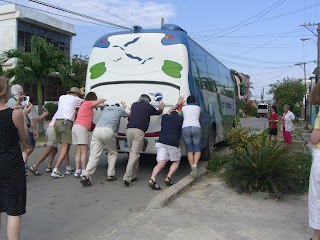 Above: Havana as seen from La Habana Vieja.
Above: Havana as seen from La Habana Vieja.The week went so fast--too fast. This Sunday morning, after an early breakfast, we all boarded the bus for a two and a half hour trip from Viñales to Havana's José Martí International Airport. Only one person out of the group stayed for an additional week in Cuba. Vicky and I would not get home until late on Monday night, because plane connections are hugely spaced out, but we arranged to spend the night in Mexico City, so at least we'd be able to rest.
Below: Havana's Christ as seen from La Habana Vieja.
 It's too soon for me to have processed all the lessons learned while in Cuba, but I can say with certainty that the trip was worth every penny. It was a fabulously fun learning experience, one that can't be replaced by reading or even knowing people from the island. I wish I could have spent at least a month there, but that just means I'll have to carve time to return.
It's too soon for me to have processed all the lessons learned while in Cuba, but I can say with certainty that the trip was worth every penny. It was a fabulously fun learning experience, one that can't be replaced by reading or even knowing people from the island. I wish I could have spent at least a month there, but that just means I'll have to carve time to return. So, in this final posting I'll simply let you enjoy a few of my favorite pictures, some taken by Vicky.
Below: near the plaza in Viñales, top on my list of all the pictures I took during the week.


 Below, Conrado Benitez who was killed during the literacy campaign in 1961 simply because he was teaching people to read and write.
Below, Conrado Benitez who was killed during the literacy campaign in 1961 simply because he was teaching people to read and write. Below, peeking into Ernest Hemingway's private life, a receipt given to him for payment he made to dock his yatch, Pilar.
Below, peeking into Ernest Hemingway's private life, a receipt given to him for payment he made to dock his yatch, Pilar.  Below, Santeras ready to tell anyone's future at the plaza in front of the cathedral.
Below, Santeras ready to tell anyone's future at the plaza in front of the cathedral.

Yep, our bus broke down, but we had a replacement in less than an hour.

Below, tourist trees... all red and peeling!



Below, a mural at the Literacy Museum.

Pictures taken by Vicky
Below, me holding on to El Caballero de Paris/the Gentleman of Paris in La Habana Vieja. Legend has it that he was a proud and kind homeless philosopher in 1950s Havana, and that if you touch his beard or finger, you will have good luck.

Below, the hill where Che readied his men for the revolution.



Etc.
I saw this painting at the Museo Nacional de Cuba, El Rapto de las Mulatas, painted in 1938 by Carlos Enríquez, one of the "Scandalous Painters." I know its value as an expressionist Cuban painting; I know that it references Jacques Louis David's 1799 painting, Intervention of the Sabine Women, which in turn references the ancient myth of Romulus’ founding of Rome... blah, blah, but the image is so disturbing!

Ceiba tree
Below, old picture of El Templete from the web... because I've been thinking about Ceibas, those massive sacred trees in Maya culture where they were known as "ya'axche," which means "the first tree"/the tree of life. In Maya spiritual belief the Ceiba is a model for the universe; Maya believed that Ceibas held up the sky. Cubans believe that Ceibas have magical power. We saw a young Ceiba at El Templete in Havana, planted on 19 May 1960 to replace the one that had been there since 1691. Every November people are allowed to enter the chapel and to circle the tree three times in silence, touching it, hugging and kissing it, hoping to have their wishes granted.

To read
Under the Shade of the Ceiba Tree , a novel by Betty Heisler-Samuels (Chutzpah Publishing 2002). A fictionalized account of Castro's death, the beginnings of Cuba's black population, Santería, music, folklore, and the future of Cubans on the island and in exile.
A National Georgraphic Channel series: "Inside Guantanamo."
Gracias!
Thank you to all my students, colleagues, family and friends for reading and enjoying my trip vicariously!































